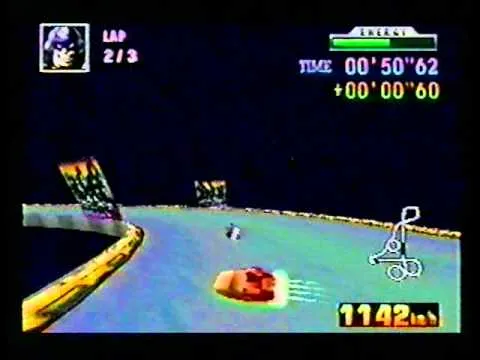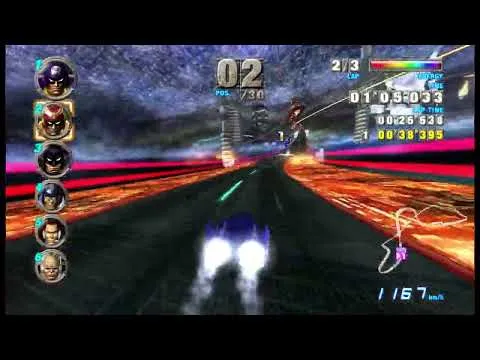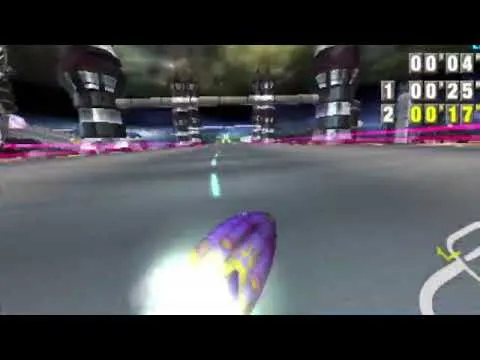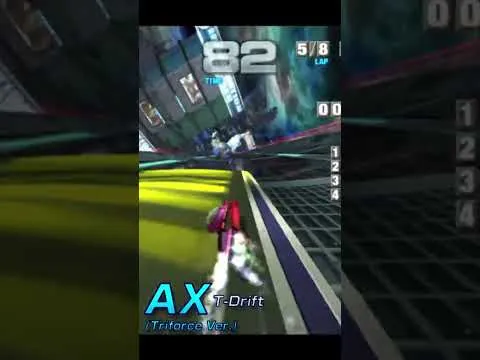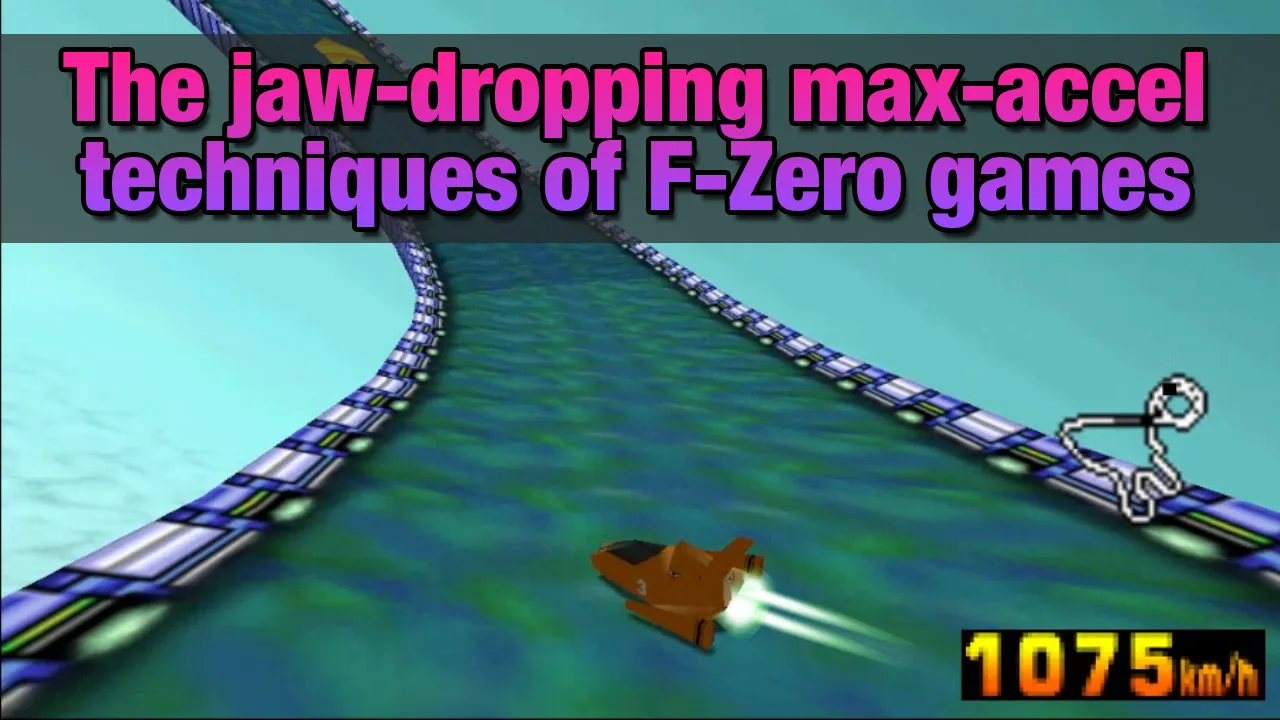

If you thought that these games were already having you breaking the sound barrier just by driving normally, then know that there's even more ridiculous ways that it can be broken!
Every game has a distinct feel with its speed and precision on the basics, and with the case of the fully 3D F-Zero games (the THREE of them), they have their own quirks and hidden tech, like how Melee and Ultimate could be theoretically played interchangeably but not only there's a difference between the usual pace and leniency of certain movements (have you ever tried doing a shorthop in Melee? Its sort of absurd how tight it is to do), but also in the high-level tech they provide.
I would call the standard way of driving with max speed in F-Zero the "fundamentals", in the same way that in Smash Bros there are things you have to get a basic grip of before going into combos and applying pressure strategies: Steer with the analog stick precisely, use your side attacks to swerve out of danger (and attack other enemies), and use wisely your boosts to gain the lead while avoiding certain death by depletion.
This "max speed" is regarding how you can tweak whether to have a balanced ratio between both Acceleration and Max Speed, prioritize Acceleration for quicker recovery and response, or instead trade off your immediate acceleration in exchange for higher top speeds which could make a difference in long stretches of road.
...But if the ideal way of racing and catching high speeds is to got for a balanced or max speed setting...then what do you do with the Acceleration setting?
Slipping and Sliding
F-Zero games have often had moments of slippery handling in one way or another, and voluntarily or against your will.
- The original F-Zero and Maximum Velocity feels loose and can go around like a pinball if you bump anything.
- F-Zero X would have your machine break grip if trying to turn too tightly at a certain speed depending of your grip (so machines with "A" grip would rarely break grip unless you bumped something at a very high speed...and machines with "E" grip are prone to start slipping unless you steer carefully depending of your speed).
- F-Zero GX also had the possibility of losing your grip when steering at high speeds, but it was much more machine dependant since the displayed stats aren't always accurate at all (most "A" grip machines like White Cat and Hyper Speeder did keep their stability though).
- The later GBA games, GP Legend and Climax, went back to the "Mode 7" gameplay but most machines without poor grip felt much more solid to handle than SNES/MV, closer to X and GX with the energy boosts and side attacks at your disposal.
- And at the time of writing this, I can't tell you from experience yet (unfortunately) about F-Zero 99's handling, but it also seems tighter than the original though the game pays you back with the high chance of running in with one out of 98 other racers and going pinball again.
In SNES and 99, it made for a distinct feel for the handling of the machines, forcing you to get used to the side brakes, blast tapping, and plain old proper racing curves to make it through, but in the other games, it normally makes for a hindrance with how it breaks your speed as well as likely making you spin out when trying to close in the race...but in those games, some machines were "made" to exploit the physics with their poor grip.
While it was seemingly known as long as 2000 from this GameFAQ's guide by Karl Jobst (yes, THAT Karl Jobst), with how some of the staff ghosts CLEARLY use this mechanic with certain tracks (only that you can't see the ghost slide as the ghosts don't show that), using max accel with low grip machines to gain insane speed while drifting was an intended mechanic, or at the very least something they discovered and had their fun with some tracks.
As you can guess, the most slippery of cars like Blood Hawk and Night Thunder (excellent in everything BUT grip) go from "dangerously risky" to "drifting devils". Though the effectiveness does depend of the track, on those tracks that they can take advantage of sliding, they absolutely destroy the competition, and as I mentioned there seem to be some tracks where they even use it, like here in Silence 2 where I can get a 1'25 time...but the Blood Hawk staff ghost has a 1'22 where they start fast and gain sudden speed at the very first turn, a clear sign they also used the slider strat.
And while that is not the only technique in F-Zero X to your advantage, it is certainly the easiest one to apply out of what you could use through the physics, as the rest are pretty advanced...but their usage on the right hands combined with the Slider strat on tracks where its good can lead to runs like these.
While this run here does use a handful of extra techniques (such as that diving and side attacking to gain extra speed), you can tell in most of the winding turns that drifting is used to keep speed while going through those, which is what's expected to be done with the Slider strat and more tracks with long curves like Silence 2.
The road of the snake
GX had completely different physics from X which erased the existence of the "gain speed sliding with max accel strat", as rather than gaining speed from turning while having a broken grip...it just had you keep the average expected speed, if not losing more. This makes machines with low grip much more demanding to use with your steering precision (Blood Hawk in particular became a former shell of itself not only because of the lack of drift exploits, but also because it got its max speed severely reduced).
There's techniques like MTS and MTS chaining which seems to help getting speed off drifts...but despite how long I have played GX, I'll admit that I have no idea how to use this one (or haven't ever used it before) to be able to comment on it. It definitely isn't the same as sliding in X where you could just break grip and straight up ride the rails for speed (as long as you had enough energy).
There are machines that still get some bursts of speed from drifting with a broken grip (like BURNING VIPER G4 I think), but for the most part, the game favours more the classic max speed gameplay with its tight controls and tracks demanding you for precise corrections with the side attack and steering (and can add techniques like MTS to your arsenal for faster times).
Unless you are willing to sell your hands to Black Shadow just to get a taste of the power of snaking.
Yet another max-accel exploit that became notorious after its discovery, it consisted in steering AND using the side brakes at the same time repeatedly, going "left" with the stick and L trigger, then "right" with the stick and R trigger, and repeat "left-right-left-right-left-right" as if you were moving like a snake; hence the name.
For whatever reason, the machine gains absurd levels of speed just from this little trick, and can trivialize both Grand Prix races and Story mode missions whenever the tracks themselves give you enough room for breath to attempt it (or your are good/insane enough to even attempt that; PLEASE do not try to beat Story 7 with Snaking like I did unless you are absolutely sure you know how to do it or are willing to pour a few hours tryinG).
I always found funny that you can use snaking in Chapter 4 of the Story Mode to easily catch up with Michael Chain (in order to destroy him) in all three difficulties to then unlock Fat Shark, which is THE definitive snaking machine and the one vehicle to use in tracks that have a lot to give through Snaking. And if you don't have that yet, the normally purchaseable Black Bull also works well for snaking.
Arcade-style action
And now here's the reason why I had started writing this in the first place. This was originally supposed to be just a little thing talking about AX and its particular way with drifting since it stood out for me from the way GX played, but I then ended up writing quite a bit about the way the other games had their tricks with max acceleration...so I just ended having all three in there.
But in any case, AX controls are the biggest difference aside from the immediately playable content (exclusive tracks and characters that ARE unlockable in GX but with a lot of effort...except Fat Shark if you are willing to snake, as I just described 😅) and normally being in an arcade cabinet.
Aside from being designed for a wheel and thus using a control scheme similar to F-Zero X (tap side brakes twice for side attacks, tap both repeatedly for spin attack; GX had dedicated buttons for both actions), what you might notice at first when playing at all...is that the machine just loves to gain speed when drifting.
What is a powerful option only in the right conditions in X (and situationally useful with right machines in GX), is essentially a free gift for most machines in AX with how easy it can be to break grip, or as the game actually refers to it, starting a drift by tapping the brake, and slide around the turns at high speed. It reminds me of both X's Slider technique along with both Scud Race/SEGA Super GT and Outrun 2, which also had unreasonably high speed drifting as their main appeal.
And then there's T-Drifting.
It is a technique that combines this simpler drifting tech with the max accel setting and a bit of trickery to turn your normally situational drift boosts (as you would have to...well, be taking on sharp turns for the speed gains) into essentially being able to blast off at over 2000km/h AND 3000km/h at will even in straight roads.
It might not seem insane if you are just looking at the tutorial (which SHOULD give you an idea of how much speed you can pick up just from that), but when you take a run at runs that push T-Drifting hard into the time trials...hoo boy, you see that its like turning your hyper futuristic rocket machine into...
...Huh, I guess they ALREADY are hyper futuristic rocket machines. Guess they are just going into MAXIMUM OVERDRIVE then.
I haven't got as used to it like THAT, but I have got my fair share of fun and failures from trying to do the trick. Take these clips as a taste of the power and its inherent dangers.
And if you want to make sure the visual difference between the GX and AX techniques...
Conclusion
Wanted to take the chance that I have finally got done the recent University stuff for this week to write about whatever I had in mind (which happened to be F-Zero again; I'd like to blame F-Zero 99 videos now appearing a lot on my Youtube feed).
As I happened to finally catch a breather out of recent university activities (I was grinding to finish a website with Github Pages and bootstrap for an assignment...the mission was succesful 😄), I could soon get to post more with some more free-form stuff like this out of whatever I find to showcase (or revisit one of the hundreds of game my game remembers to talk you about), so I hope you can look forward to that :)
Thanks for reading!

Spanish translation with DeepL. All screenshots were captured by myself.
Español
Si pensabas que estos juegos ya te hacían romper la barrera del sonido simplemente conduciendo con normalidad, ¡entonces debes saber que hay formas aún más ridículas de romperla!
Cada juego tiene una sensación distinta con su velocidad y precisión en lo básico, y en el caso de los juegos de F-Zero en 3D (los TRES), tienen sus propias peculiaridades y tecnología oculta, como Melee y Ultimate, que en teoría podrían jugarse indistintamente, pero no sólo hay una diferencia entre el ritmo habitual y la indulgencia de ciertos movimientos (¿has intentado alguna vez hacer un cortocircuito en Melee? Es absurdo lo difícil que es hacerlo), sino también en la tecnología de alto nivel que ofrecen.
Yo llamaría "fundamentos" a la forma estándar de conducir a máxima velocidad en F-Zero, del mismo modo que en Smash Bros hay cosas que tienes que dominar de forma básica antes de entrar en combos y aplicar estrategias de presión: Dirigir con el stick analógico con precisión, usar tus ataques laterales para desviarte del peligro (y atacar a otros enemigos), y usar sabiamente tus potenciadores para ganar ventaja mientras evitas una muerte segura por agotamiento.
Esta "velocidad máxima" se refiere a cómo puedes ajustar si quieres tener una proporción equilibrada entre Aceleración y Velocidad máxima, priorizar la Aceleración para una recuperación y respuesta más rápidas, o en cambio intercambiar tu aceleración inmediata a cambio de velocidades máximas más altas que podrían marcar la diferencia en largos tramos de carretera.
...Pero si la forma ideal de competir y alcanzar altas velocidades es conseguir una configuración equilibrada o de velocidad máxima... ¿entonces qué haces con la configuración de Aceleración?
Deslizamiento y derrape
Los juegos de F-Zero han tenido a menudo momentos de manejo resbaladizo de una forma u otra, y de forma voluntaria o en contra de tu voluntad.
- El F-Zero original y Maximum Velocity se siente suelto y puede dar vueltas como un pinball si chocas con algo.
- F-Zero X hace que tu máquina pierda agarre si intentas girar con demasiada fuerza a cierta velocidad dependiendo de tu agarre (así, las máquinas con agarre "A" rara vez pierden agarre a menos que choques con algo a gran velocidad... y las máquinas con agarre "E" son propensas a empezar a resbalar a menos que dirijas con cuidado dependiendo de tu velocidad).
- En F-Zero GX también existía la posibilidad de perder agarre al conducir a altas velocidades, pero dependía mucho más de la máquina, ya que las estadísticas mostradas no siempre eran del todo precisas (la mayoría de las máquinas con agarre "A", como White Cat e Hyper Speeder, mantenían la estabilidad).
- Los últimos juegos de GBA, GP Legend y Climax, volvieron al "Modo 7", pero la mayoría de las máquinas sin mal agarre se sentían mucho más sólidas de manejar que las de SNES/MV, más cercanas a X y GX con los aumentos de energía y los ataques laterales a tu disposición.
- Y en el momento de escribir esto, aún no puedo hablarte por experiencia (por desgracia) del manejo de F-Zero 99, pero también parece más firme que el original, aunque el juego te lo devuelve con la alta probabilidad de toparte con uno de los otros 98 corredores y volver a hacer pinball.
En SNES y 99, la sensación de manejo de las máquinas era distinta, ya que te obligaba a acostumbrarte a los frenos laterales, a los golpes y a las curvas típicas de las carreras, pero en los otros juegos, suele ser un obstáculo, ya que reduce la velocidad y puede hacerte perder el control cuando intentas cerrar la carrera... pero en esos juegos, algunas máquinas estaban "hechas" para explotar la física con su escaso agarre.
Aunque al parecer ya se sabía en el año 2000 por esta guía de GameFAQ de Karl Jobst (sí, ESE Karl Jobst), con la forma en que algunos de los fantasmas del personal utilizan CLARAMENTE esta mecánica con ciertas pistas (sólo que no se puede ver el deslizamiento fantasma ya que los fantasmas no lo muestran), usar la aceleración máxima con máquinas de poco agarre para ganar una velocidad demencial mientras se derrapa era una mecánica prevista, o al menos algo que descubrieron y se divirtieron con algunas pistas.
Como puedes adivinar, los coches más resbaladizos como Blood Hawk y Night Thunder (excelentes en todo MENOS en agarre) pasan de ser "peligrosamente arriesgados" a "demonios del drifting". Aunque la efectividad depende de la pista, en aquellas pistas en las que pueden sacar ventaja del deslizamiento, destrozan absolutamente a la competencia, y como mencioné parece que hay algunas pistas en las que incluso lo usan, como aquí en Silence 2 donde puedo conseguir un tiempo de 1'25...pero el fantasma del personal de Blood Hawk tiene un 1'22 donde empiezan rápido y ganan velocidad repentina en la primera curva, una clara señal de que también usaron la estratagema del deslizamiento.
Y aunque esa no es la única técnica en F-Zero X que te puede beneficiar, es sin duda la más fácil de aplicar de todas las que puedes usar a través de las físicas, ya que el resto son bastante avanzadas... pero su uso en las manos adecuadas combinado con el Slider strat en pistas donde es bueno puede llevar a carreras como estas.
Aunque en esta carrera se utilizan un puñado de técnicas adicionales (como la zambullida y el ataque lateral para ganar velocidad extra), en la mayoría de las curvas sinuosas se puede ver que se utiliza el derrape para mantener la velocidad mientras se atraviesan, que es lo que se espera que se haga con el Slider strat y más circuitos con curvas largas como Silence 2.
El camino de la serpiente
GX tenía una física completamente diferente a X que borraba la existencia de la "gain speed sliding with max accel strat", ya que en lugar de ganar velocidad al girar teniendo un agarre roto... simplemente te hacía mantener la velocidad media esperada, si no perder más. Esto hace que las máquinas con poco agarre sean mucho más difíciles de usar con precisión de dirección (Blood Hawk, en particular, se convirtió en un cascarón de sí mismo, no sólo por la falta de exploits de derrape, sino también porque su velocidad máxima se redujo drásticamente).
Hay técnicas como MTS y MTS chaining que parecen ayudar a conseguir velocidad en los derrapes... pero a pesar de lo mucho que he jugado a GX, admito que no tengo ni idea de cómo usarlas (o no las he usado nunca) como para poder opinar sobre ellas. Definitivamente no es lo mismo que deslizarse en X, donde podías romper el agarre y montarte directamente en los raíles para ganar velocidad (siempre que tuvieras suficiente energía).
Hay máquinas que todavía consiguen algunas ráfagas de velocidad derrapando con un agarre roto (como el BURNING VIPER G4, creo), pero en su mayor parte, el juego favorece más el clásico modo de juego de máxima velocidad con sus controles ajustados y pistas que te exigen correcciones precisas con el ataque lateral y la dirección (y puedes añadir técnicas como MTS a tu arsenal para conseguir tiempos más rápidos).
A menos que estés dispuesto a vender tus manos a Sombra Negra sólo para probar el poder del serpenteo.
Otro exploit de max-aceleración que se hizo famoso tras su descubrimiento, consistía en dirigir Y usar los frenos laterales al mismo tiempo repetidamente, yendo "a la izquierda" con el stick y el gatillo L, luego "a la derecha" con el stick y el gatillo R, y repetir "izquierda-derecha-izquierda-derecha-izquierda-derecha" como si te estuvieras moviendo como una serpiente; de ahí el nombre.
Por la razón que sea, la máquina gana niveles absurdos de velocidad sólo con este pequeño truco, y puede trivializar tanto las carreras de Grand Prix como las misiones del modo Historia siempre que las propias pistas te den suficiente espacio para respirar como para intentarlo (o seas lo suficientemente bueno/insano como para siquiera intentarlo; POR FAVOR, no intentes superar la Historia 7 con Snaking como hice yo a menos que estés absolutamente seguro de que sabes cómo hacerlo o estés dispuesto a pasar unas cuantas horas intentándolo).
Siempre me ha hecho gracia que puedas usar el Snaking en el capítulo 4 del modo Historia para alcanzar fácilmente a Michael Chain (con el fin de destruirlo) en las tres dificultades para luego desbloquear el Fat Shark, que es EL Snaking definitivo y el único vehículo para usar en pistas que tienen mucho que dar a través del Snaking. Y si aún no lo tienes, el Toro Negro, que normalmente se puede comprar, también funciona bien para el snaking.
Acción estilo Arcade
Y ahora aquí está la razón por la que había empezado a escribir esto en primer lugar. Se suponía que esto iba a ser sólo un pequeño comentario sobre AX y su particular forma de derrapar, ya que para mí destacaba de la forma en que se jugaba en GX, pero luego acabé escribiendo bastante sobre la forma en que los otros juegos tenían sus trucos con la aceleración máxima... así que acabé teniendo los tres ahí.
Pero en cualquier caso, los controles de AX son la mayor diferencia aparte del contenido inmediatamente jugable (pistas y personajes exclusivos que SON desbloqueables en GX pero con mucho esfuerzo...excepto Fat Shark si estás dispuesto a serpentear, como acabo de describir 😅) y el estar normalmente en un mueble arcade.
Aparte de estar diseñado para un volante y, por tanto, usar un esquema de control similar al de F-Zero X (tocar dos veces los frenos laterales para ataques laterales, tocar ambos repetidamente para ataque giratorio; GX tenía botones dedicados para ambas acciones), lo que puedes notar al principio al jugar algo... es que a la máquina le encanta ganar velocidad al derrapar.
Lo que en X es una opción poderosa sólo en las condiciones adecuadas (y en GX es útil en determinadas situaciones con las máquinas adecuadas), en AX es básicamente un regalo para la mayoría de las máquinas, con lo fácil que es romper el agarre o, como lo llama el juego, iniciar un derrape tocando el freno y deslizarse por las curvas a gran velocidad. Me recuerda tanto a la técnica Slider de X como a Scud Race/SEGA Super GT y Outrun 2, que también tenían como principal atractivo el derrape a alta velocidad.
Y luego está el T-Drifting.
Se trata de una técnica que combina esta tecnología de derrape más sencilla con el ajuste de aceleración máxima y un poco de astucia para convertir tus aumentos de derrape normalmente circunstanciales (ya que tendrías que... bueno, estar tomando curvas cerradas para ganar velocidad) en algo esencialmente capaz de salir disparado a más de 2000 km/h Y 3000 km/h a voluntad incluso en carreteras rectas.
Puede que no parezca una locura si te limitas a ver el tutorial (que debería darte una idea de la velocidad que puedes alcanzar sólo con eso), pero cuando te pones a correr en carreras que exigen mucho T-Drifting en las contrarrelojes... vaya, ves que es como convertir tu hipermáquina de cohetes futurista en...
...Huh, supongo que YA son máquinas de cohetes hiper futuristas. Supongo que sólo van a MAXIMUM OVERDRIVE entonces.
Yo no me he acostumbrado a eso, pero me he divertido y he fracasado intentando hacer el truco. Tome estos clips como una muestra de la potencia y sus peligros inherentes.
Y si quieres asegurarte de la diferencia visual entre las técnicas GX y AX...
Conclusión
Quería aprovechar que por fin he terminado las cosas recientes de la Universidad para esta semana para escribir sobre lo que tenía en mente (que resultó ser F-Zero de nuevo; Me gustaría culpar a F-Zero 99 vídeos que ahora aparecen mucho en mi feed de Youtube).
Como por fin he podido tomarme un respiro de las recientes actividades universitarias (tenía que terminar un sitio web con Github Pages y bootstrap para una tarea...la misión fue un éxito 😄), pronto podré publicar más cosas de forma libre como esta de cualquier cosa que encuentre para mostrar (o volver a visitar uno de los cientos de juegos de los que mi juego se acuerda para hablaros), así que espero que podáis contar con ello :)
¡Gracias por leer!

Traducción al español hecha con DeepL. Todas las fotos capturadas por mí.

